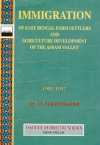INNOVATIVE PIONEERS BY MOHD ZEYAUL HAQUE (July 18, 2004)

IMMIGRATION
Of East Bengal Farm Settlers And Agriculture Development of the Assam Valley 1901-1947
Dr. M. Sujaud Doullah
Rs: 130
Pages: 200
Institute of Objective Studies,
New Delhi - 110025
Since the beginning of the 20th century Assam has been in a demographic flux, a flux that has tended to enrich it in terms of economic productivity and cultural diversity. However, as the century moved on, a certain clash of interests developed between the Muslim new comers and the older immigrants from Burma (i.e., the largely Hindu Ahom who predominate in every field of Assamese life) as well as the indigenous tribals.
Most of us have witnessed over the last few decades the intense ethnic and communal rivalries and the politics based on all these negative trends. Massacres and mayhem have become the wrap and insurgency the woof of Assamese political life.
This book begins at the beginning of the 20th century and ends with the independence and partition of India in 1947, much before the rivalries could really play themselves out as they did in the years after 1947. It focusses on the migration of Muslim peasants from erstwhile East Bengal to Assam. After 1947, East Bengal became East Pakistan and, from 1971, Bangladesh.
The author posits certain “push factors” that repelled the migrants from East Bengal, and corresponding “pull factors” that made Assam draw them in. The push factors included overpopulation of East Bengal, its floods, meagre agricultural incomes and an adverse land-holding pattern that concentrated big land holdings in a few Hindu zamindar hands while leaving the peasantry landless and perennially destitute.
The pull factors included abundant empty space in Assam valley that the government of the day (and most other important players) would not object to being brought under cultivation by settled farmers.
Waves after waves of East-Bengal farmers brought a new level of prosperity and productivity to Assam. The East Bengalis were far more hard-working and innovative then their Assamese counterparts. The pioneering spirit combined with better agricultural practices and skills led to the introduction of multiple-crop farming in the Assam valley, besides other more productive practices, of course.
As long as the new settlers were confined to secluded areas everything was trouble-free. But once they came in proximity with the locals, jealousies and animosities began to grow.
The book, a Ph D thesis, is based on painstaking research. The account presented here negates the general anti-Muslim propaganda that Muslim presence in Assam has had a baneful influence on the course of Assamese history. It should be of immense help to people studying Assam’s demography, politics and economics.
Go Back